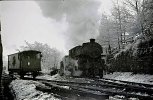Hi all,
Following a recent trip to the area my interest has been sparked somewhat in the latter years of the above railways. I was just wondering if anyone could help with a few questions I had around the above. Broadly I'm talking about 1970 onwards - so:
1. Hartley Quarry - I can, so far, work out that this quarry remained open until the late 70s. I believe it was a limestone quarry. Trains would have had to access the quarry from the S&C at Appleby and then done a run around before heading up the Eden Valley railway to the quarry. But, where abouts did these trains go to? What wagons were used to convey limestone (was it limestone itself, or further processed to something else?), and does anyone have further details on the method of work at Appleby? It seems like lots of shunting would have been required, and due to the relatively short head shunt between the Eden Valley and the connecting line, I can't imagine especially long trains could be accommodated?
2. Warcop - I understand military trains ran here. I've never actually seen a military train in the flesh so, what was typically conveyed and on what vehicles (both in general terms and to Warcop specifically)? Where did these trains originate and how regularly did they run? When did this flow dry up?
3. Eastgate quarry - I understand this output cement that was conveyed in PCA wagons. However, does anyone know the frequency the line was used and any destinations the trains typically served?
4. Is there any other quarries/mines etc in the area that maintained a rail link into the 1970s-1990s (ie: after the closure of the rest of the railways in the North Pennine/Weardale area).
Many thanks to anyone who knows!
Following a recent trip to the area my interest has been sparked somewhat in the latter years of the above railways. I was just wondering if anyone could help with a few questions I had around the above. Broadly I'm talking about 1970 onwards - so:
1. Hartley Quarry - I can, so far, work out that this quarry remained open until the late 70s. I believe it was a limestone quarry. Trains would have had to access the quarry from the S&C at Appleby and then done a run around before heading up the Eden Valley railway to the quarry. But, where abouts did these trains go to? What wagons were used to convey limestone (was it limestone itself, or further processed to something else?), and does anyone have further details on the method of work at Appleby? It seems like lots of shunting would have been required, and due to the relatively short head shunt between the Eden Valley and the connecting line, I can't imagine especially long trains could be accommodated?
2. Warcop - I understand military trains ran here. I've never actually seen a military train in the flesh so, what was typically conveyed and on what vehicles (both in general terms and to Warcop specifically)? Where did these trains originate and how regularly did they run? When did this flow dry up?
3. Eastgate quarry - I understand this output cement that was conveyed in PCA wagons. However, does anyone know the frequency the line was used and any destinations the trains typically served?
4. Is there any other quarries/mines etc in the area that maintained a rail link into the 1970s-1990s (ie: after the closure of the rest of the railways in the North Pennine/Weardale area).
Many thanks to anyone who knows!

